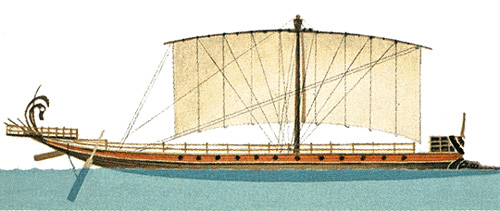Galley, << GAL ee, >> was a long, narrow, wooden warship. It was widely used by the navies of ancient Mediterranean nations. Galleys had an open deck with at least one mast and set of sails. They were also equipped with one or more rows of oars on each side. Galleys traveled under sail when wind permitted. Rowing was used for speed and maneuvering in battle, and also in emergencies.
Two ancient Mediterranean civilizations—the Minoans of Crete and the Mycenaeans of mainland Greece—first built galleys between 2000 and 1000 B.C. A large metal ram (point) was fitted to the front of the galleys. The ram was used in battle to punch holes in the sides of enemy vessels. By about 700 B.C., a galley called a bieres was developed, probably by the Phoenicians or the Greeks. The Romans later called this type of ship a bireme. It featured two banks (rows) of oarsmen on each side, one above the other, to provide more speed and ramming power. Until then, all galleys had only a single row of oarsmen on each side. By about 500 B.C., the Greeks introduced the trieres. later called the trireme by the Romans. The ship had three banks of oars on each side. Each trieres carried a crew of about 200. Later, the Greeks built galleys with four and then five banks of oarsmen.
The Romans used galleys similar to those of the Greeks. The Romans also added a second set of sails to their galleys. The oarsmen of Roman galleys were not slaves, as is often believed. Rather, they were noncitizen subjects of the Roman Empire, mainly from the Balkans and Egypt. As the speed of other types of ships increased, the galleys began to disappear. Mediterranean galleys were probably used for the last time in warfare at the Battle of Matapan in 1717.

